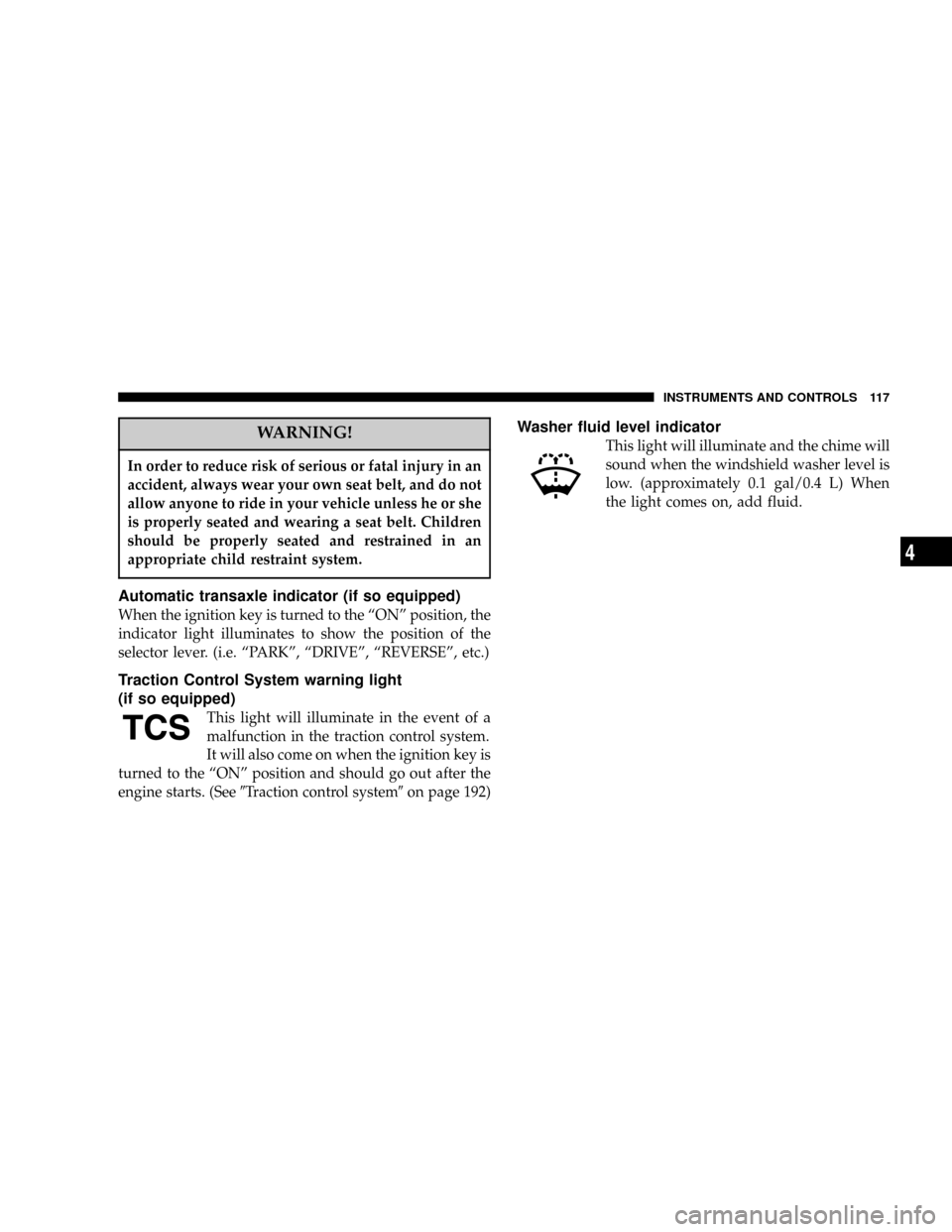Page 116 of 382

Seat belt reminder/warning light
A chime and warning light are used to
remind the driver to fasten the seat belt.
When the ignition key is turned to the
``ON'' position, the warning light will illu-
minate and a chime will sound for about 6
seconds. If the driver 's seat belt remains unfastened
approximately 1 minute later, the warning light will flash
and the chime sound intermittently (each 12 times) when
the vehicle is driven. If the driver subsequently unfastens
the seat belt while driving, the warning light and chime
will issue further warnings. And if the seat belt remains
unfastened, the warning light and chime will issue
further warnings each time the vehicle starts moving.
When the seat belt is fastened, the warnings will stop.
Changing the setting for warning operation
It is possible to disable the warning function so that
warnings are not issued after the start of driving. (The
function is initially enabled at the factory.)
1. Fasten the driver 's seat belt.
2. Turn the ignition switch to the ``ON'' position.3. With the seat belt still fastened, confirm that the
warning light goes off.
4. Within 1 minute of seeing the warning light go off,
remove the plate from the buckle and re-insert it 3 times.
5. Turn the ignition switch to the ``LOCK'' or ``ACC''
position. The buzzer (with a short tone) will sound once
to indicate that the setting change is complete.
NOTE
²
If the driver 's door is open at this time, the buzzer
(with long intermittent tones) will sound continously
but the setting change will not be completed. To
complete the setting change, remove the key or close
the driver 's door. The buzzer (with a short tone) will
sound once to indicate that the setting change is
complete.
²If you wish to change the setting again, perform the
same procedure again.
²If you do not understand how to change the setting,
consult an authorized Mitisubishi dealer.
116 INSTRUMENTS AND CONTROLS
Page 117 of 382

WARNING!
In order to reduce risk of serious or fatal injury in an
accident, always wear your own seat belt, and do not
allow anyone to ride in your vehicle unless he or she
is properly seated and wearing a seat belt. Children
should be properly seated and restrained in an
appropriate child restraint system.
Automatic transaxle indicator (if so equipped)
When the ignition key is turned to the ªONº position, the
indicator light illuminates to show the position of the
selector lever. (i.e. ªPARKº, ªDRIVEº, ªREVERSEº, etc.)
Traction Control System warning light
(if so equipped)
This light will illuminate in the event of a
malfunction in the traction control system.
It will also come on when the ignition key is
turned to the ªONº position and should go out after the
engine starts. (See9Traction control system9on page 192)
Washer fluid level indicator
This light will illuminate and the chime will
sound when the windshield washer level is
low. (approximately 0.1 gal/0.4 L) When
the light comes on, add fluid.
INSTRUMENTS AND CONTROLS 117
4
Page 122 of 382
NOTE
1. If the headlights are switched to high beam, the fog
lights will go out; they will illuminate again when the
headlights are switched back to low beam.
2. If the light switch is rotated to OFF while the fog lights
are illuminated, they will automatically turn off. They
can be turned back on again by moving the light switch
back to ON and pressing the fog light switch again.
HAZARD WARNING FLASHER SWITCH
Press the flasher switch and the front and rear turn
signals will flash intermittently, as the hazard warning
lights. This is an emergency warning system and is not
intended for use when the vehicle is in motion.
If it is necessary to leave the vehicle, the flasher system
will continue to operate with the ignition key removed.
NOTE: If the lights are kept flashing for several hours,
the battery will be discharged (rundown), resulting in
hard engine starting or a no start condition.
E16A0520
122 INSTRUMENTS AND CONTROLS
Page 146 of 382

NOTE:Tighten the gas cap until you hear a ªclickingº
sound. This is an indication that the gas cap is properly
tightened.
The Malfunction Indicator Light (ªSERVICE ENGINE
SOONº) will come on if the gas cap is not properly
secured. Make sure that the gas cap is tightened each
time the vehicle is refueled.
WARNING!
A fire may result if gasoline is pumped into a
portable container that is inside of a vehicle. You
could be burned. Always place gas containers on the
ground while filling.
Fuel Filler Cap (Gas Cap)
The gas cap is behind the fuel filler door, on the passen-
ger's side of the vehicle. If the gas cap is lost or damaged,
be sure the replacement cap is for use with this vehicle.
CAUTION!
Damage to the fuel system or emission control
system could result from using an improper fuel
tank filler tube cap (gas cap). A poorly fitting cap
could let impurities into the fuel system.
CAUTION!
A poorly fitting gas cap may cause the Malfunction
Indicator Light (ªSERVICE ENGINE SOONº) to
turn on.
WARNING!
²Never have any smoking materials lit in or near
the vehicle when the gas cap is removed or the
tank filled.
²Never add fuel to the vehicle when the engine is
running.
146 STARTING AND DRIVING
Page 149 of 382

THEFT PROTECTION
CAUTION!
Always remove the key from the ignition switch and
lock all doors when leaving the vehicle unattended.
Always try to park your vehicle in a well lighted
area.
The ignition key can only be removed in the ªLOCKº
position. If the key is left in the lock cylinder, a warning
chime sounds when the driver's door is opened.
NOTE: If your vehicle is equipped with a Theft-alarm
system, refer to ªTheft-alarm systemº.
STEERING LOCK
Withdraw the key and the steering wheel will be locked.
Turn the steering wheel to confirm that it is locked.
CAUTION!
If your vehicle needs to be towed, turn the key to the
(ACC(position to unlock the steering wheel.
STARTING
Tips for starting
1. Do not operate the starter motor continuously for
longer than 15 seconds at a time; doing so could run
down the battery. If the engine does not start, turn the
ignition switch back to ªLOCKº, wait a few seconds, and
then try again.
2. If the engine will not start because the battery is weak
or dead, refer to ªJump-starting the engineº section (page
273) for instructions on starting the engine.
3. The engine is well warmed up if the pointer of the
coolant temperature gauge starts to move. Extended
warm up operation will result in excessive fuel consump-
tion.
STARTING AND DRIVING 149
5
Page 150 of 382

WARNING!
Never run the engine in a closed or poorly ventilated
area any longer than is needed to move your vehicle
in or out of the area. Carbon monoxide gas, which is
odorless, colorless and extremely poisonous, could
build up, and cause serious injury or death.
CAUTION!
²Do not start the vehicle by pushing or pulling.
²Do not run the engine at high rpm or drive the
vehicle at high speed until the engine has had a
chance to warm up.
²Release the ignition key as soon as the engine
starts to avoid damaging the starter motor.
This vehicle is equipped with an electronically controlled
fuel injection system that automatically controls fuel
quantity. When starting the engine, there is normally no
need to depress the accelerator pedal.
Normal conditions
The starting procedure is as follows:
1. Insert the ignition key and make sure all occupants are
properly seated with seat belts fastened.
2. Depress and hold the brake pedal down with your
right foot.
3. Set the gearshift selector lever (manual transaxle) in
the ªNº (NEUTRAL) position, or the selector lever (au-
tomatic transaxle) in the ªPº (PARK) position.
4. Fully depress the clutch pedal (manual transaxle).
NOTE: For models equipped with a manual trans-
axle, the starter will not operate unless the clutch
pedal is fully depressed (Clutch interlock).
5. After turning the ignition key to the ªONº position,
make certain that all warning lights are functioning
properly before starting the engine.
6. Turn the ignition key to the ªSTARTº position without
depressing the accelerator pedal, and release the key
when the engine starts.
150 STARTING AND DRIVING
Page 159 of 382
WARNING!
Always depress the brake pedal when shifting the
selector lever into a gear from the ªNº (NEUTRAL)
position. When beginning to drive, do not shift the
selector lever from the ªNº (NEUTRAL) position
while depressing the accelerator pedal; doing so may
cause the vehicle to ªjumpº forward or backward.
CAUTION!
If the button is always depressed to operate the
selector lever, the lever may be accidentally shifted
into the ªPº, ªRº position. Be sure not to depress the
button when performing the operations indicated by
in the illustration.
NOTE:
If the brake pedal is not depressed and held, the
shift-lock device activates to prevent the selector lever
from being moved from the ªPº (PARK) position.Indicator lights
A - Selector lever position indicator light
B - ªNº indicator light
The indicator lights in the instrument panel are for
indicating the selector lever position (A).
I04A3420
ª
STARTING AND DRIVING 159
5
Page 160 of 382

If the ªNº indicator light in the instrument panel flashes,
there could be a malfunction with the automatic transaxle
system. Identify and take action in accordance with the
following procedures:
1. The ªNº indicator light flashes rapidly (twice per
second) in the ªDº or ªAutostickº range.
If this occurs, the automatic transaxle fluid is overheat-
ing. Park your vehicle in a safe place but do not turn off
the engine. Move the selector lever to the ªPº position
and open the hood. Keep the engine idling.
After a while, move the selector lever to the ªDº or
ªAutostickº position and confirm that the ªNº indicator
light stops flashing. It is safe to continue driving if the
ªNº light no longer flashes.
Be sure to carry out this check with the selector lever in
the ªDº or ªAutostickº position. The ªNº indicator light
warning function operates only in the ªDº or ªAutostickº
range.
If the ªNº indicator light continues flashing or flashes
intermittently, have your vehicle inspected by an autho-
rized dealer.2. The ªNº indicator light flashes slowly (once per
second) in the ªDº or ªAutostickº range.
The automatic transaxle safety device may be operating
due to a malfunction.
Have your vehicle inspected by an authorized dealer as
soon as possible.
Selector positions (Main gate)
P-PARK
This position locks the transaxle to prevent the vehicle
from moving. The engine can be started in this position.
R - REVERSE
Shift into this position only after the vehicle has come to
a complete stop.
CAUTION!
Never shift into the ªPº (PARK) or ªRº (REVERSE)
position while the vehicle is in motion. If the lever is
shifted into the ªPº or ªRº position while the vehicle
is in motion, the transaxle may be damaged.
160 STARTING AND DRIVING